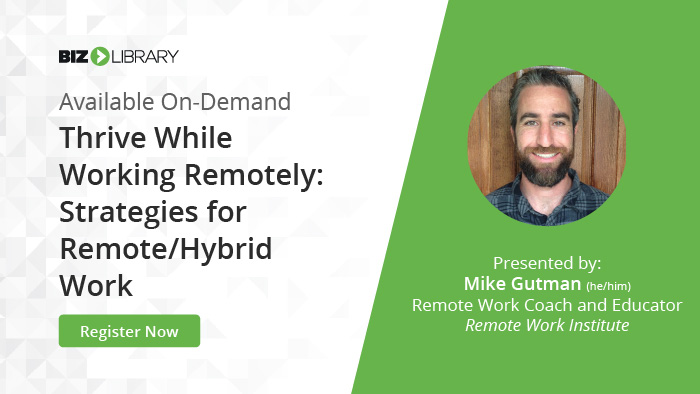We had a great webinar full of insightful tips for managing a remote or hybrid workforce. During the webinar, Mike Gutman answered questions about establishing guidelines and standards for employees, how to handle proximity bias, and more. He couldn’t get to all the questions, so he has answered a few more questions in this blog!
Remote/Hybrid Work Q&A with Mike Gutman
Remote Work Coach and Educator
Q: What are some unique tips on how to support emotional wellbeing while working in a hybrid environment?
First, it’s imperative to create psychological safety with teammates and allow for conversations about how outside stressors, like mental health and family circumstances, might be impacting work. The more we know about each other’s lives, the more we can support each other. Creating a safe space to have those conversations is the trick.
Also, schedule team wellness breaks to chop up the day. For example, take a five-minute walk around the parking lot, stretch out muscles, or complete some meditation. If everyone is taking time for paid wellness breaks, it will be easier for this to become the norm.
And be sure to model good behavior from the top down. If leadership is investing in wellness and work/life balance for themselves, they can create an environment where this type of good behavior is encouraged for all employees.
Q: Remote work seems to be an “all work and no play” scenario. What are your suggestions for engaging employees and staying excited about the job?
I disagree with this assumption and instead propose that the shape of play at work has changed. Because meetings are often planned and intentional, it can feel like there’s a lack of social time with colleagues. So, to make more time for play at work, it needs to be intentional or scheduled.
In the office, it’s perfectly normal to go out and grab a coffee with someone for a break, but in a remote setting, that’s not the social norm. But think about this – a team that encourages people to ping them over instant messenger to take a quick video coffee break or a team that encourages walk and talk meetings.
Social norms can change. As mangers and leaders, you just have to introduce them and ask employees how they would go about making it fun.
Check out this video preview of one of Mike’s lessons he created for our new Expert Insight Series of content videos.
Q: What ideas do you suggest for employee recognition in this type of environment?
This one is simple. Ask people how they want to be recognized. Give them options of whether that want to be recognized publicly or privately and the type of recognition they want to receive (praise or rewards).
Q: How do you develop the same relationships with those offsite as those onsite?
There are a few things you can do. First, make sure everyone is having regular check-ins with everyone else on their team. The cadence of the check-ins can be varied to fit the needs of each person, and topics can range from casual conversations to more serious work-related topics. Make time for intentional touch points that you all have with each other so you can continue relationship building and avoid things like proximity bias.
Secondly, you can create digital channels for everyone to communicate on the same platform. Slack, Microsoft Teams, or GChat can make it easy to create spaces to talk about pets, TV shows, books, etc. The point of this is to create a space where everyone, regardless of location, can interact.
Thirdly, be sure to call out proximity bias – or in-office people favoring other in office staff and leaving the remote workers behind. Share that you want to avoid that and if anyone feels like it’s happening, to speak up. Creating awareness around the potential pitfall allows people to come together and try to avoid it.
Q: Is there something to the “people need to be in the office and have that person-to-person connection to thrive” thought process?
This thought process is old school. Instead, I would counter with “Thrive in order to do what?” Feel like they are connected to a larger goal and team? Be creative and come up with new ideas? For leadership to better manage a workforce?
When you start to ask questions, the answers always come back to one conclusion: these things are able to be accomplished from anywhere.
I agree that human to human connection in person is valuable and should happen on teams, but it should also be intentional and make the best use of in-person time. If people are coming into the office just because management thinks that is a better way to run a business, then I would question management’s ability to lead a remote team.
If you’d like more tips on thriving while your team is working remotely or in a hybrid setting, be sure to check out the on-demand webinar.
About Mike Gutman
Mike Gutman has been leading remote teams for 15 years. As the former marketing director for FlexJobs, Mike helped connect the value of work flexibility to employer strategy and job seekers, including running corporate conferences on remote work strategy for fortune 100 companies. He is a Linkedin Learning author on topics such as remote work policy, remote work management, and day-to-day best practices. He currently helps corporate leadership teams figure out their remote and hybrid work models as offices are starting to open back up.
